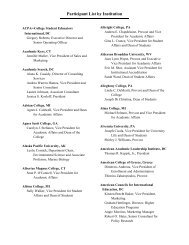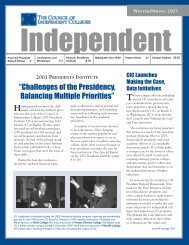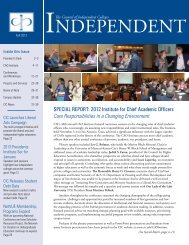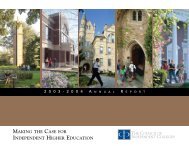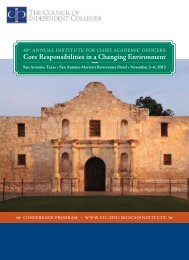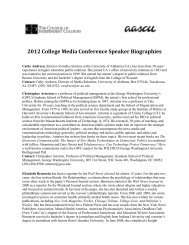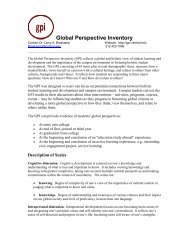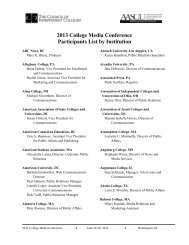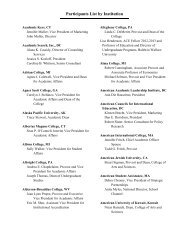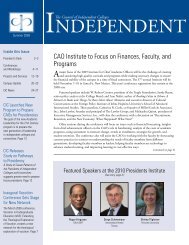Annual Report 2006-2007 - The Council of Independent Colleges
Annual Report 2006-2007 - The Council of Independent Colleges
Annual Report 2006-2007 - The Council of Independent Colleges
You also want an ePaper? Increase the reach of your titles
YUMPU automatically turns print PDFs into web optimized ePapers that Google loves.
<strong>The</strong> State <strong>of</strong> our Sector<br />
As an association dedicated to serving<br />
independent colleges and universities, CIC has<br />
had an excellent year, with growth in membership,<br />
programs and services, and financial support. But<br />
the true measure <strong>of</strong> CIC’s success is not in the<br />
progress <strong>of</strong> the organization itself, but rather in the<br />
health <strong>of</strong> the institutions that CIC serves. By that<br />
measure, the 582 colleges and universities (fouryear,<br />
two-year, and international) that are CIC members also are doing<br />
very well. While not every institution is succeeding equally well in all<br />
respects, the aggregate picture <strong>of</strong> the state <strong>of</strong> the country’s small and<br />
mid-sized private colleges and universities is encouraging.<br />
Undergraduate enrollment at CIC’s four-year member institutions<br />
was 1,142,660 in <strong>2006</strong>–<strong>2007</strong>, up 2 percent from the previous year.<br />
Endowment asset value was $3.6 billion at the end <strong>of</strong> 2005–<strong>2006</strong>, up<br />
from $3.2 billion (or 9 percent) from the previous year. Average faculty<br />
salaries rose 3.5 percent, with the salary for full-time full pr<strong>of</strong>essors<br />
averaging $67,302. In addition, leadership <strong>of</strong> our colleges is proving<br />
durable: the average length <strong>of</strong> a private college presidency is now eight<br />
and a half years (while the tenure <strong>of</strong> public university presidencies<br />
averages less than eight years).<br />
Higher education became a subject for more widespread public<br />
discussion during the past year, thanks largely to the Secretary <strong>of</strong><br />
Education’s pointed statements about our alleged shortcomings.<br />
Happily, private colleges and universities have risen to these challenges<br />
and are playing a leading role in meeting the Secretary’s focus on<br />
national priorities.<br />
• <strong>Independent</strong> colleges are continuing to make college attendance<br />
affordable and accessible for deserving students.<br />
• <strong>The</strong> proportion <strong>of</strong> students receiving Pell Grants at small and<br />
mid-sized independent colleges is higher than at public research<br />
universities (31 percent versus 24 percent).<br />
• Four out <strong>of</strong> five college graduates earning an undergraduate<br />
degree from private colleges and universities do so in four years<br />
or less, compared with just half <strong>of</strong> students at public institutions.<br />
• “At risk,” low-income or first-generation students attending<br />
private colleges and universities are twice as likely to graduate as<br />
at-risk students at public institutions.<br />
Also thanks to Secretary Spellings, there has been much attention<br />
during the past year to measures <strong>of</strong> the “learning outcomes” <strong>of</strong> a college<br />
education. Well before the Secretary’s call for assessment, however,<br />
CIC was a leader in encouraging institutions to take seriously the<br />
assessment <strong>of</strong> student learning. As early as 2002, CIC was the first<br />
national association to promote the use <strong>of</strong> the National Survey <strong>of</strong><br />
Student Engagement (NSSE) and to embrace the Collegiate Learning<br />
Assessment (CLA). CIC and its member institutions believe that<br />
data collection and analysis are essential steps toward institutional<br />
self-improvement. This year, CIC’s consortium <strong>of</strong> 33 colleges and<br />
universities that are using the CLA and sharing results remains the<br />
largest group <strong>of</strong> institutions working together voluntarily to seek<br />
continuous improvement in helping students to learn. <strong>The</strong> Teagle<br />
Foundation has recognized CIC’s role by awarding a large grant that<br />
will make it possible to expand the consortium’s work for another three<br />
years. <strong>The</strong> point here is that voluntary efforts are underway; there is no<br />
need for federal interference.<br />
But the picture is not entirely positive, and private higher<br />
education still faces important challenges. On behalf <strong>of</strong> all smaller<br />
colleges, CIC is trying to engage some <strong>of</strong> the more troubling issues. For<br />
example, despite the compelling statistics on student access and success,<br />
many journalists and policymakers persist in fueling the misperception<br />
that private colleges are only for affluent young people. Despite the<br />
disproportionate contributions <strong>of</strong> private colleges to preparing graduates<br />
to enter fields critical to American society, small colleges are too <strong>of</strong>ten<br />
treated as an after-thought rather than leaders in providing the most<br />
promising solutions to major national issues.<br />
CIC’s Making the Case website and the persuasive data to be<br />
found there attempt to address these misconceptions. Additional facts<br />
are these:<br />
• Twenty percent <strong>of</strong> all new school teachers graduate from CIC<br />
colleges, despite enrolling only 7 percent <strong>of</strong> all students attending<br />
four-year colleges and universities.<br />
Thomas Aquinas<br />
College, CA<br />
<strong>2006</strong>–<strong>2007</strong> <strong>Annual</strong> <strong>Report</strong> •



